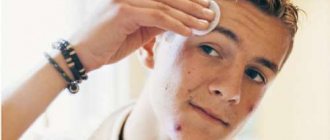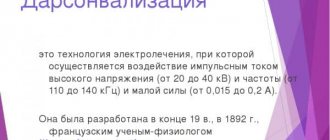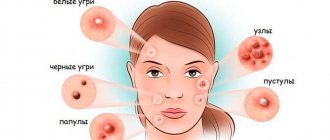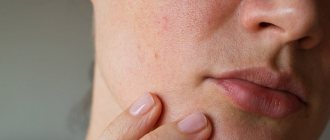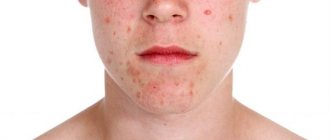Papular acne is the formation of papules on the skin, which are bumps with a hard consistency and a size of more than 1 centimeter. They are visible to the naked eye and can be felt under the finger when touched. Follicular lesions are mainly located on the facial skin in the T-zone, that is, on the forehead, nose and chin. This is an area of increased sebum and sebum production.
Papular acne is the most common and problematic form of acne. Treatment of papular acne requires medication and proper care.
Causes of acne
Propionibacterium acne, Staphylococcus epidermidis, Pityrosporum ovale and orbiculare constantly live on the skin of the face. Propionic bacteria produce lipase and increase the desquamation of the epithelium of the mouths of hair follicles, which leads to their blockage.
Many factors contribute to the development of acne:
- One of the reasons for the appearance of acne on the face is a “hormonal surge” in teenagers. Hair follicles, sebaceous and sweat glands exhibit increased sensitivity to androgens. Under their influence, the sebaceous gland begins to produce and secrete an increased amount of sebum.
- An increased amount of male sex hormones may be hereditary. Hereditary predisposition consists of an inadequate response of the sebaceous glands to increased levels of androgenic (male) hormones in the blood.
- Severe acne occurs in men with an XYY karyotype (tall, mild mental retardation, and aggressive behavior).
- Promotes the development of seborrhea acne.
- Eating large amounts of carbohydrates and diabetes mellitus create favorable conditions for the development of infection (carbohydrates are a good breeding ground for pyogenic microbes).
- Failure of the body's thermoregulatory system.
- Long-term use of corticosteroids.
- Long-term stress and depression.
- Petroleum products, lubricating oils and dioxin can cause acne if they come into contact with the skin.
- The development of acne is provoked by taking oral contraceptives, drugs containing bromine, phenytoin, and lithium salts.
- Prolonged squeezing of the skin or friction leads to mechanical closure of the follicle ducts and the development of acne.
Rice. 2. The photo shows the structure of a hair follicle. The sebaceous gland is indicated in yellow.
Medicines and food
Often, acne can be the result of using the wrong medications or antidepressants. The reaction is approximately the same as with an unhealthy diet, which contains many chemical additives. This includes sweet soda, various chips and similar products.
Very fatty foods, salty, sweet and even spicy in large quantities can harm the body, which will primarily manifest itself through the human skin.
How acne appears
Pimples on the skin of the face, chest and back appear in areas where a large number of sebaceous glands are located. In common forms, acne appears on the skin of the shoulders and forearms. The disease can be mild (open comedones), moderate in severity (closed comedones and papules), and severe (pustules).
Stage I: comedones formation
When the processes of exfoliation of the stratum corneum of the skin are disrupted, retention hyperkeratosis develops (delayed exfoliation). The mouth of the follicle becomes clogged with horny scales, as a result of which sebum accumulates in the cavity of the follicle. A microcomedone (milium) is formed, obstructing (closing) the excretory duct of the sebaceous gland. Over time, open and closed comedones are formed - non-inflammatory elements in acne.
Rice. 3. Microcomedones are formed when sebum accumulates in the ducts of the sebaceous glands and the mouths of the follicles. They look like small hemispherical nodules of milky color.
Rice. 4. In the photo, comedones are open in the area of the external auditory canal. With open comedones, the openings of the follicles are open. Under the influence of environmental oxygen, the fats that make up sebum oxidize, which gives comedones a black color.
Rice. 5. The photo shows open comedones on the face.
Rice. 6. In the photo, the comedones on the face are closed. With closed comedones, the openings of the follicles are closed. Horny scales and sebum, having no way out, remain under the epithelium layer.
Rice. 7. The photo shows elements of acne. Mild - mild degree of severity. Modtrant - moderate severity. Severe - severe course - abundant papules and pustules, abscess formation and the formation of fistulous tracts.
Stage II: development of inflammation
Lack of oxygen, dead horny scales and sebum create conditions for the proliferation of propionobacteria acne - permanent representatives of the skin microflora.
- Acne propionobacteria have the ability to break down sebum and cause inflammation of surrounding tissues, which leads to the development of papules. With the formation of large inflammatory infiltrates, an indurative form of acne develops.
- When a staphylococcal infection is attached, pustules (ulcers) and microabscesses develop - pustular, abscessing, necrotic and phlegmonous acne. These forms of acne are severe.
- With necrotic acne, inflammation develops deep in the follicles. Most often, acne appears on the skin of the forehead and temporal area. Pustules with hemorrhagic contents appear on their tops. After opening them, a scab forms. The disease ends with the development of a smallpox scar.
- With phlegmonous acne, the inflammatory process penetrates and develops in the subcutaneous fatty tissue. When a purulent lesion is opened, thick, creamy pus is released. The course of the disease is long. Deep scars remain in place of acne.
- With the development of multiple abscesses, an infiltrate with several fistulous tracts is formed (nodular cystic acne). Extensive infiltrates after healing leave cyst-like formations.
- The fulminant form of acne is more often recorded in boys aged 14–17 years and women. The disease is extremely severe and has a malignant course. Symptoms of intoxication are significantly expressed, symptoms of arthralgia are noted, and the functioning of the gastrointestinal tract is disrupted.
Initially, areas of the skin turn red and swelling develops. After a few days, boil-like rashes appear on the skin. Pustules can reach enormous sizes. Foci of necrosis form. After healing, rough scars remain.
Rice. 8. The photo shows acne on the face (papular acne).
Rice. 9. The photo shows acne on the face. When a staphylococcal infection is attached, pustules (ulcers) and microabscesses develop - pustular and abscessing acne.
Rice. 10. The photo shows pustular acne.
Rice. 11. The photo shows an indurative form of acne. The inflammatory process affects neighboring areas and penetrates deep into the tissue. Pustules are located on a dense base. Infiltrates are often extensive, their surface is bumpy. The disease leaves rough, disfiguring scars.
Rice. 12. The photo shows nodular cystic acne. Nodes more than 1 cm in diameter, always painful, protrude deep into the dermis, often merge, forming extensive infiltrates with fistulous tracts. When healing occurs, cyst-like formations remain. The skin of the face is most often affected.
Rice. 13. The photo shows cystic acne.
Rice. 14. In the photo, the acne on the back and chest is conglobate (spherical). Nodules, ulcerations, cysts and abscesses are the main elements of inflammation. The diameter of the nodes reaches 1 - 4 cm. Merging, the nodes form sharply painful conglomerates. Long-term non-healing abscesses often form. Healing occurs with the formation of rough bridge-shaped scars. The skin of the torso and chest is affected, much less often - the face. Acne conglobates occur in men with an additional Y chromosome, less often in women suffering from polycystic ovary syndrome.
Rice. 15. The photo shows excoriated acne. The disease occurs when pimples are scratched and squeezed out. Sometimes this condition develops into neurosis, which is characterized by behavior deviating from the norm.
Stage III: acne healing
All types of juvenile acne leave scars. When the pustules heal, small atrophic (smallpox-like) scars remain, sometimes pigmented.
When spherical, abscessive and phlegmonous acne heals, hypertrophic and, less commonly, keloid scars remain, disfiguring the skin.
Rice. 16. Atrophic scars form after healing of pustular acne.
Rice. 17. The chronic course of the disease often ends with the formation of scar tissue.
Rice. 18. The photo shows acne keloid (keloid acne). In the back of the head, dense pink rashes are visible, which are inflammation of the follicles located at the border of smooth skin and scalp. The disease is long-lasting and torpid. The affected areas become sclerotic over time.
Causes of acne on the face in men, depending on location
The location of acne does not indicate problems in the functioning of the body:
- Nose. This area contains a significant number of sebaceous glands. If they are overactive, you should expect the appearance of pimples and blackheads in men. Sometimes rashes are provoked by pathologies of the heart and blood vessels, digestive tract, weakened immunity, and endocrine disorders. Purulent elements in the area of the bridge of the nose indicate disruptions in the functioning of the liver.
- Lips. Pimples around the mouth in men are a sign of gastrointestinal imbalance. Chronic diarrhea or heartburn is often observed. Pimples in the lip area are caused by manifestations of herpes virus infection.
- Forehead. This area also contains a large number of sebaceous glands. Often, acne on the forehead can be noticed in teenagers due to hormonal fluctuations. The causes of acne on the forehead in men are considered to be dysfunction of the gallbladder, intestines or pancreas. Purulent elements in the eyebrow area indicate the progression of dysbiosis.
- Chin. Acne on the chin more often appears in men after 30 years of age due to the abuse of alcoholic beverages and fatty, spicy foods. Rashes of this localization indicate problems with the endocrine or digestive system. It is also impossible to exclude pathologies of the kidneys or liver, a significant amount of toxins in the body.
- Back. Acne on the upper back can be a consequence of increased sweating due to hormonal imbalances, lipid metabolism disorders, and dermatological diseases.
Seborrhea and acne
Hair follicles, sebaceous and sweat glands show increased sensitivity to male sex hormones. Under their influence, the sebaceous gland begins to produce and secrete an increased amount of sebum. The more sebum is produced, the more severe the acne. The balance between female and male sex hormones is disrupted (increasing the latter) in the period 14 - 25 years.
Increased sebum production is observed with seborrhea. Seborrheic background can be thick, liquid and mixed. Acne develops against the background of a thick or mixed form of oily seborrhea, which is most often recorded in adolescents, less often in boys. Mixed seborrhea appears more often on the face, dry seborrhea on the scalp. Long-term use of glucocorticoids, anabolic steroids, testosterone and progesterone, and disruptions in the functioning of the autonomic nervous system contribute to the development of seborrhea.
Rice. 19. The photo shows steroid acne. The disease occurs as a result of long-term use of fluorinated and non-fluorinated corticosteroids. There are no comedones. The rashes are of the same type and disappear after discontinuation of the drug.
The appearance of acne in an adult is a reason to consult an endocrinologist.
How to get rid of acne on your face at home
How to get rid of acne on your face? This is a question that 9 out of 10 people have asked and are asking in their lives. Acne is reported in 85% of adolescents and 20% of adults. They appear on the face, back and chest. Half of all women experience acne on their faces regularly. Acne appears in a person up to the age of 50.
Acne is located on the skin of the face, chest and back - in areas where the largest number of sebaceous glands are located. The disease can be mild (open comedones), moderate in severity (closed comedones and papules), and severe (pustules).
Acne is a serious disease. Only a doctor knows how to get rid of acne on the face, back and chest. However, you can do a lot yourself at home.
Conducting a clinical and laboratory examination of the patient, finding out the causes of acne and identifying risk factors is the responsibility of the doctor before starting treatment.
Treating acne on the face, chest and back is not an easy task. As soon as acne appears, you should immediately consult a doctor. The doctor will help you understand the causes of the disease. Perhaps, along with external therapy, the doctor will recommend general therapy, hyposensitizing, detoxification and vitamin therapy. A mandatory component of complex treatment is a balanced and rational diet.
- Sexually transmitted infections, polycystic ovary syndrome, gastritis, which is caused by Heliobacter, are often combined with early forms of acne.
- Uterine fibroids, mastopathy, pelvic inflammatory diseases, recurrent candidiasis, bacterial vaginosis and other diseases caused by hormonal dysfunction are often combined with late forms of acne.
Drug treatment for acne must be adequate and consistent.
External therapy is prescribed for mild to moderate acne. It is intended to use creams, gels, ointments and lotions containing substances that:
- prevent the formation of comedones or destroy them,
- reduce sebum production,
- prevent the development of inflammation.
General therapy is prescribed when local therapy is ineffective and severe acne and involves the use of:
- antibiotics,
- synthetic derivatives of vitamin A (isotretinoin),
- specific immunotherapy drugs,
- antiandrogens.
Limiting the intake of easily digestible carbohydrates, the amount of animal fats, extractives and table salt are the basic principles of dietary nutrition in the treatment of acne.
Hormonal state
The teenage years are both a wonderful, carefree time and a real hell for a growing organism. The body is going through one of the most active stages of development and change, which is accompanied by severe hormonal instability. This is influenced by testosterone, which everyone knows very well. Its excess is primarily reflected on the skin, and especially on the face of a teenager.
Acne at this age is a normal thing and you just have to get over it. Proper nutrition and minimal skin care greatly simplifies the situation. But getting a teenager to do this is sometimes extremely difficult.
Hormonal levels can also be affected by diseases of various organs, problems with which disrupt the functioning of the body. We are talking about kidney problems, diabetes, and even cancer is included in this category.
Skin cleansing is an essential component of daily care.
Daily cleansing of the skin is a must when treating acne on the face and other parts of the body. Foams, gels and lotions are used for this purpose. They remove excess oil and do not dry out the skin. It is not recommended to use soap. The frequency of washing when treating acne should not exceed 1 - 2 times a day.
- Cleansing gel (France) cleanses the skin well. In this case, the hydrolipid film is not damaged.
- The cleansing gel is part of the Exfoliak series of medicinal cosmetics (France).
- Cleansing lotion and gel for washing are included in the preparations of the Klerasil Ultra series.
- Gel for cleansing facial skin is part of the products of the Cetaphil, Sebium and Sphingogel series.
- Cleansing gel for oily skin is part of the Zeniak series.
Degrease and disinfect the skin with alcohol solutions with antibiotics (5% chloramphenicol), 2% resorcinol, 1 - 2% salicylic acid solution, 5 - 10% alcohol solution of camphor.
Frequent washing leads to increased dryness of the skin and a decrease in its protective properties.
Cleansed skin is treated with tonic. For acne, preference should be given to tonics that contain keratolytics and comedolytics. These products have the ability to exfoliate dead cells, prevent the accumulation of sebum and horny scales in the mouths of the follicles, and reduce inflammation.
Rice. 20. The photo shows acne on the face.
Reducing sebum production, normalizing the processes of keratinization and death of epidermal cells, suppressing microflora and reducing inflammation are the basic principles in the treatment of acne.
Air
Problems with air exchange often affect the condition of the skin. The main reason lies in low-quality cosmetics. We are talking about shampoo or soap that you use every day. All of them have a rather complex composition, which may include not only mineral additives, but also various chemical elements, which sometimes turn out to be harmful.
In some cases, the problem may be individual, because no two people are alike, and therefore the shampoo that suits your brother may be a bad choice for you.
There is another very simple example - a hat. Since childhood, we have been taught to remove our hats indoors. The whole point here is not only about manners, but about problems that may arise with health.
If you stay in a warm enough room wearing a hat for at least ten minutes, you will notice how your head begins to sweat profusely. This is a reaction to overheating, and the body is simply trying to lower the temperature of an area of the body. In general, areas of heavy sweating are places where men can develop acne.
Using keratolytics to treat acne at home
In the cells of the epidermis, the process of keratinization constantly occurs, as a result of which keratin protein and fats are deposited in the stratum corneum, which is why it becomes strong and elastic. When the processes of exfoliation of the stratum corneum of the skin are disrupted, retention hyperkeratosis develops. The mouth of the follicle becomes clogged with horny scales, as a result of which sebum accumulates in the cavity of the follicle, forming microcomedones and open and closed comedones.
Keratolytic drugs normalize the keratinization processes occurring in the mouths of the follicles, preventing the formation of microcomedones and conditions for the development of bacteria.
Benzoyl peroxide (Baziron, OXU-5, OXU-10, Klerasil-ultra)
Benzoyl peroxide is an organic compound. The drug has been used in the treatment of acne for many years. It has the ability to kill propionic acid bacteria without causing the emergence of resistant strains. Its keratolytic and comedolytic action allows the drug to be used not only for the correction of open and closed comedones, but also for the treatment of inflammatory elements of acne. Benzoyl peroxide does not affect sebum production. The drug is available in various forms (cleansing gel, tonic, scrub, corrective preparations), which makes it convenient to use in various settings (at home, at work, while traveling, etc.).
Rice. 21. In the photo, Baziron and Retin-A are keratolytics and comedolytics, widely used in the treatment of acne of various locations.
Retinoid drugs
Preparations of the retinoid group are structurally close to vitamin A. A representative of the retinoid group is the drug Retin-A, containing tretinoin. It has a keratolytic and comedolytic effect, reduces sebum production, has a weak anti-inflammatory effect, and helps smooth the skin. The drug promotes the opening of closed comedones and their transition to papules, followed by healing without scars.
Adapalene (Klenzit, Differin) is a synthetic analogue of retinoic acid. Used topically for comedones. Adapalene in combination with an antibiotic (Klenzit-S) is used when inflammatory elements of acne appear. The retinoid isotretinoin (Roaccutane) is prescribed for severe acne.
Rice. 22. In the photo, Klenzit and Klenzit-S are synthetic analogues of retinoic acid. The drugs are widely used in the treatment of comedones.
Azelloic acid
Azelloic acid is included in the preparations Skinoren, Azelik, Azix-Derm. It stops the growth and reproduction of propionic acid bacteria. Under its influence, the fraction of free fatty acids in the surface lipids of the skin decreases and the proliferation of keratinocytes is inhibited. The drug is available in the form of cream and gel.
Rice. 23. The photo shows acne products Skinoren and Azelik for topical use with azeloic acid.
Salicylic acid
Salicylic acid has antimicrobial and keratolytic properties (coagulates proteins, including microbial ones), improves tissue trophism, and reduces pain.
Rice. 24. In the photo, the acne remedy is salicylic acid (solution for external use).
Resorcinol
Resorcinol is an antiseptic. By coagulating proteins, the drug thereby has a keratolytic effect and has an antipruritic effect.
When using acne products, carefully read the instructions for use of the drug and strictly follow its instructions. Stick to the drug use plan! Consult your doctor if side effects occur and discuss the results of acne treatment with your doctor.
Features of acne treatment in men
The prevention and treatment of acne occupies a very important place in a man’s life. This is due precisely to the fact that for the first time we encounter this when we are thirteen years old.
- atrophic gastritis treatment
- Men's signets: old new trend
- 3 types of medical gloves and why you should buy them in the MEDSTOR online store
Before the age of nineteen, almost half of guys suffer from acne problems. Over the next five to six years, the situation gets better, but about five percent of young men continue to struggle with acne even at this time.
There are only one percent of men who have to live almost their entire lives with acne, which can come and go as life goes on.
Some young people are sure that this is only due to age, that nothing can be done about it, and that they just need to wait until they grow up.
But this is a misconception, because there is almost always an effective treatment for acne in men, which is not always medicinal. Sometimes inaction during adolescence places a young person in the five percent who continue to confront this problem even in their student years.
To do this, you just need to take care of personal hygiene, improve your diet, only if even after this the problem is not solved, you can safely go to a dermatologist for advice.
Antimicrobials for treating acne at home
For inflammatory elements of acne in the form of papules and pustules, antibacterial drugs for external use can be used independently, since they do not have the pronounced effectiveness of systemic antibiotic therapy.
Topical preparations suppress the growth of bacteria:
- Benzoyl peroxide (Baziron AS) gel.
- Azelloic acid (Skinoren) gel and cream.
- Fusidic acid ointment, cream.
- Erythromycin ointment.
- Clindamycin (Dalacin-gel).
- Lincomycin ointment.
- Metronidazole gel.
- Pyolysin ointment.
- Zenerite (erythromycin/zinc acetate) powder.
- Zinc hyaluronate (Curiosin) gel.
Degrease and disinfect the skin with alcohol solutions with antibiotics (5% chloramphenicol), 2% resorcinol, 2 - 5% salicylic acid solution, 5 - 10% alcohol solution of camphor.
Don't squeeze pimples! When squeezed, the infection spreads into the deep layers of the skin and non-inflamed elements.
What to do if acne appears on your face
In order for a man to get rid of acne, it is necessary to determine the cause of its occurrence. It is recommended to consult a specialist and undergo the necessary diagnostics.
The severity of the inflammatory process on the skin can be reduced through adequate care. Acne often appears in men after careless shaving or using inappropriate cosmetics.
To prevent the formation of pimples after shaving, you need to adhere to the following rules:
- carry out the procedure after taking a bath or shower, since the skin is steamed;
- Shave only along the hair growth;
- promptly replace the machine and blades;
- use cosmetics that have a disinfectant and anti-inflammatory effect.
Attention! For isolated rashes on the chin, you can use salicylic acid. This product tightens pores, disinfects the skin and eliminates excess oily shine. For severe acne, you should consult a doctor.
Therapeutic cosmetics for acne treatment
Modern medicinal cosmetics will help you get rid of acne. Her choice should be based on the form of acne and the severity of the disease. Medicinal cosmetics should have a keratolytic, sebum-regulating and antibacterial effect, and should clean and moisturize the skin well.
Today there are many lines of medicinal cosmetics for acne treatment on the market:
- Products from the Exfoliak series (France), including hygiene gel and creams for the treatment of acne of varying severity.
- Therapeutic cosmetics “Aven” from the “Cleanans” line. It has a sebum-regulating and keratoregulating effect.
- Products from the series “Clerasil Ultra”, “Cetaphil”, “Zeniac”.
Remedies for acne for sensitive skin are represented by La Roche Pose thermal water, Toleran Fluid protective emulsion, and Rosaliac products.
Efaklar products and the Klerasil Ultra treatment series are especially designed for oily skin.
Curiosin and Mederma gels, Piolysin ointment, Diaknel cream with a unique combination of retinaldehyde and glycolic acid prevent the development of scar tissue and even out the skin texture. They help smooth out the skin texture and prevent the formation of scars.
Rice. 25. The photo shows anti-acne products from the “Clerasil” line.
If you have acne, you should not sunbathe. Excessive sun exposure increases sebum production.
How to prevent acne: 7 ways
Like most problems in our lives, acne is not always completely under control. Therefore, instead of wondering how to get rid of acne quickly, it will be more effective to take preventive measures. Here's what might help:
- Never go to bed without washing your face thoroughly.
- Read the labels of facial care products carefully. Pay attention to labels such as “non-comedogenic” or “will not clog pores.”
- Avoid touching your face during the day with unwashed hands (try to touch it as little as possible).
- Always shower after exercising.
- Try to reduce your stress levels.
- Some pimples are not acne, but post-inflammatory pigment changes from previous pimples or attempts to squeeze them out. Apply sunscreen with SPF 30+ daily (even on cloudy days) to prevent darkening of these spots.
- There is some scientific evidence that certain dietary changes can help reduce the risk of developing acne. For example, one meta-analysis of observational studies involving nearly 80,000 children, adolescents and young adults found an association between dairy products and an increased risk of acne. Additionally, some studies have linked foods with a high glycemic index (those that cause your blood sugar levels to rise quickly) to acne.
How to get rid of acne on your back and prevent its occurrence in the future? Read about this in a separate article.
- FAQs How to get rid of acne on your back? 7 most effective ways
General therapy for acne
In cases where the use of external therapy for 3 months has not produced results, as well as in severe forms of acne, general (systemic) treatment is used, which includes the use of antibiotics, synthetic derivatives of vitamin A, specific immunotherapy and antiandrogens.
Antibiotic therapy
For acne, the use of macrolide and tetracycline antibiotics for 2 to 3 weeks is indicated. Antibiotics of the cephalosporin group and gentamicin are indicated for phlegmonous acne.
Synthetic vitamin A derivatives
The substance isotretinoin is a synthetic derivative of vitamin A. The retinoid isotretinoin (the drug Roaccutane) is a dermatoprotector. The drug has anti-inflammatory, anti-acne and antiseborrheic effects. When used, terminal differentiation of cells is normalized, proliferation of the epithelium of the sebaceous gland ducts is inhibited, the formation of detritus is reduced and its evacuation is facilitated, the production of sebum is reduced and the outflow of sebum is facilitated.
Rice. 26. The photo shows the results of acne treatment with Roaccutane.
Antiandrogens
Drugs in this group (Andokur, Diane-35, Zhanin, Cyproterone, Spironolactone) reduce sebum production. Antiandrogens are prescribed to women in case of prolonged acne, when antibiotic therapy and topical isotretinoin are ineffective. Antiandrogens are used only after consultation with a gynecologist and endocrinologist. Oral intake of antiandrogens must be combined with the use of a complex of medicinal cosmetics.
Specific immunotherapy
Specific immunotherapy is indicated in the treatment of phlegmonous acne. Treatment is prescribed and carried out under the supervision of a doctor. Toxoid, antifagin, gamma globulin and other drugs are used.
Rice. 27. In the photo there are acne on the face. Heavy current. Systemic treatment is required.



